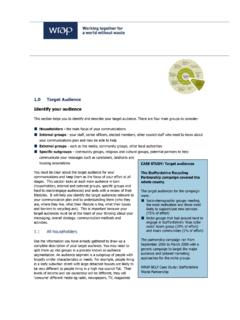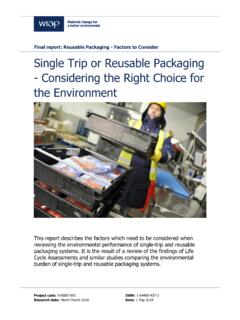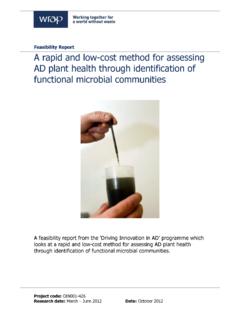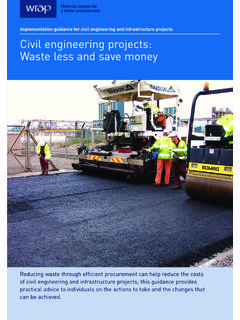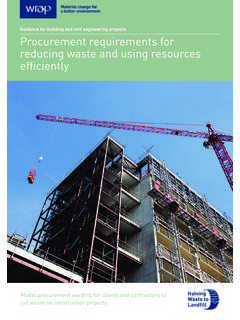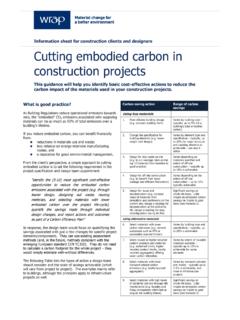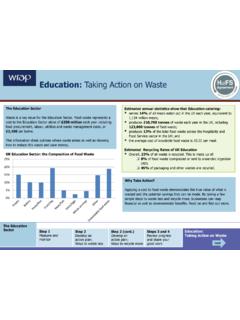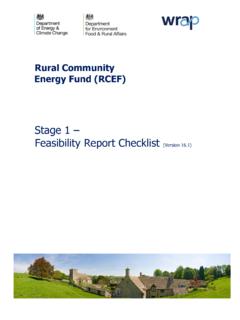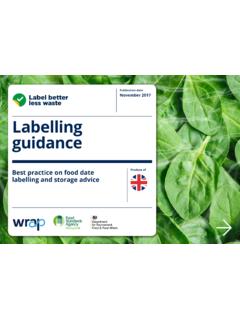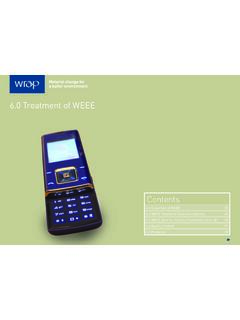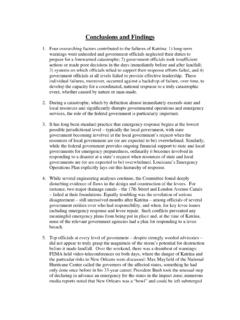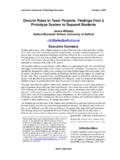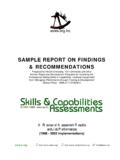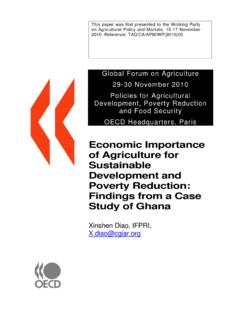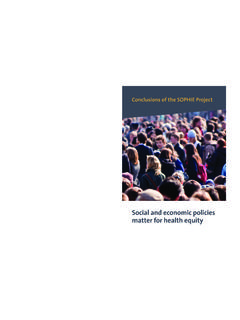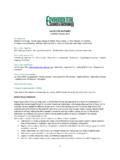Transcription of Final Report Optimisation of pallet wrapping film use
1 Final Report Optimisation of pallet wrapping film use This research reviews the use of pallet collation films in the UK grocery market and identifies opportunities to optimise their usage in the UK food and drinks sector. Project code: PAD102-306 ISBN: Research date: April June 2012 Date: March 2013 WRAP s vision is a world without waste, where resources are used sustainably. We work with businesses, individuals, and communities to help them reap the benefits of reducing waste, developing sustainable products and using resources in an efficient way. Find out more at Docmicronent reference:[ WRAP, 2006, Report Name (WRAP Project TYR009-19. Report prepared , WRAP] Written by: Peter Davey & Greg Wood Front cover photography: [Spent hand wrap cores illustrating film wastage] While we have tried to make sure this Report is accurate, we cannot accept responsibility or be held legally responsible for any loss or damage arising out of or in connection with this information being inaccurate, incomplete or misleading.)
2 This material is copyrighted. You can copy it free of charge as long as the material is accurate and not used in a misleading context. You must identify the source of the material and acknowledge our copyright. You must not use material to endorse or suggest we have endorsed a commercial product or service. For more details please see our terms and conditions on our website at Optimisation of pallet wrapping film use 3 Executive summary In 2012, as part of its efforts to support Courtauld Commitment 2 signatories and other supply chain stakeholders, WRAP commissioned a project to identify, develop and communicate good practice in the use of resources and materials in collating palletised loads using filmic materials throughout the UK grocery supply chain. The main objectives of the study were to identify opportunities to: Reduce the equivalent carbon dioxide (CO2e) impact of packaging through use of less and/or lower gauge stretch and shrink wrap for pallet load consolidation (where appropriate); Reduce stretch and shrink wrap waste arising in the supply chain through use of less and/or lower gauge stretch and shrink wrap for pallet load consolidation (where appropriate); and Reduce product wastage through improved pallet load consolidation and therefore reduce damage in the supply chain.
3 This Report presents the findings of the study along with discussion around current film and wrapping technology together with commentary explaining these opportunities and discussing some barriers to uptake. film use in the food and drinks sector is circa 77,000 tonnes per annum. Around 60% or 46,000 tonnes of wrap are used in manual wrapping operations with 31,000 tonnes or 40% used in semi or fully automated wrapping machines. By collating and extrapolating data from a variety of sources, the UK market size has been estimated and industry segmentation for palletisation stretch film shown in the table below: Market sector % of the market Tonnes Food 41 57,400 Beverages 14 19,600 Healthcare 5 7,000 Cosmetics 4 5,600 Other Consumer 17 23,800 Industrial/Bulk 20 28,000 UK Stretch film Market 100% 140,000 Source: Innventia Edge Research 2012 Developments in resins and film production methods offer the opportunity to light weight film and reduce waste.
4 These developments include: Light-weighting of films; Pre-stretched films; Coreless films for manual wrapping applications; Various solutions to the issue of necking down ; Net films. Following a detailed review of the research outputs it is possible to reach a number of important conclusions as to the current use of palletisation films: Stretch film is the primary material used in pallet stabilisation in the UK, representing >96% of the market; The UK market for stretch film in pallet stabilisation is estimated at 140,000 tonnes annually, of which 77,000 tonnes are used by the food and drinks sector; Manual wrapping accounts for around 60% of use, the remaining 40% is split between semi and fully automatic wrapping machines; Optimisation of pallet wrapping film use 4 The manufacture and supply of film is highly fragmented and although the market is consolidating this situation is likely to pertain for the foreseeable future.
5 Whilst some stability issues are experienced by retailers and wholesalers, the stability of pallets wrapped in the UK food and drinks sector is generally perceived to be good; Technological advances have resulted in new films which offer the opportunity for considerable light weighting of film whilst maintaining strength; wrapping patterns and applied film thickness should be reviewed regularly in order to take advantage of latest thinking and advances in film quality and application techniques; Anecdotal evidence from study respondents indicated that industry initiatives, such as primary and secondary packaging light-weighting and adoption of retail ready packaging, had acted as drivers for increased pallet film use. Importantly, it has been found that there are a number of undeveloped opportunities to effect significant reductions in the weight of film used by greater adoption of new films and by optimising the use of films through regular reviews and better management of wrapping operations.
6 The main recommendations of the study are: Before changing suppliers, films or load collation technologies, comprehensive plant trials should be undertaken; When buying film , the recommended metrics to use are cost per applied metre or cost per pallet wrapped (cost per tonne divided by number of pallets wrapped per tonne of film ); Operators should determine their wrapping specifications in consultation with subject experts such as film suppliers (and machine providers where applicable); Operators should consider migrating to new, lighter weight films, whilst maintaining load restraining characteristics; Semi-automatic wrapping operations should employ pre-stretched films rather than standard films to optimise film yield; Manual wrapping operations should consider migrating to coreless films in order to minimise waste arising from spent cores and film ends ; Operators should consider using stabilisation adhesives as an alternative or to reduce film use; Operators should regularly, at least annually, review their operations to ensure the optimum materials and methods are employed; and Manual wrapping operations need to be closely managed to ensure consistency and minimise film waste.
7 film usage needs to be monitored by the company on a regular basis, at least annually, and alternative options reviewed/considered and trialled if appropriate. This study has identified that there is significant scope to optimise the use of film pallet wrapping in the UK food and drink sector. Increasing the uptake of modern stretch films along with improved wrapping methods present a real opportunity to reduce the tonnage of wrapping film used by substantial amounts. The following table outlines the potential size of this opportunity for the >96% of the food and drink sector utilising stretch films, given three film technology improvement scenarios and differing rates of adoption. Optimisation of pallet wrapping film use 5 wrapping application Scenario Current usage (Tonnes) UK food & drinks sector film saving (in tonnes) assuming an additional: 10% Adoption 20% Adoption 30% Adoption 40% Adoption 50% Adoption Manual wrapping (60% of total stretch film usage in Food & Drink 77Kt) Light-weighting of film by 50% 46,200 2,310 4,620 6,930 9,240 11,550 Increased use of coreless film 4,620 tonnes of cores 462 924 1,386 1,848 2,310 2,310 tonnes of wasted film on reel ends 231 462 693 924 1,155 Machine wrapping semi and fully automatic 40% of stretch film usage in Food & Drink 77Kt) Increased use of pre-stretch film 30,800 1,386 2,772 4,158 5,544 6,930 This table presents the potential size of the opportunity given adoption of pallet adhesive stabilisation technology displacing stretch film given differing rates of adoption.
8 wrapping application Scenario Current usage (Tonnes) UK food & drinks sector film saving (in tonnes) assuming an additional: 10% Adoption 20% Adoption 30% Adoption 40% Adoption 50% Adoption Alternative pallet stabilisation technology Increased use of adhesives 77,000 7,700 15,400 23,100 30,800 38,500 Optimisation of pallet wrapping film use 6 Contents Introduction .. 11 Background .. 11 Optimising Stretch film use in the UK food & drinks sector .. 11 Aims & Objectives .. 11 Aims .. 11 Objectives .. 11 Methodology .. 12 Stage 1: Identify current practice .. 12 Onsite reviews .. 12 SME telephone interviews .. 13 Stage 2: Develop best practice .. 13 Stage 3: Communicate good practice .. 13 Good practice guidance and case studies .. 13 Development of an online tool .. 14 pallet collation film in the UK Food & Drinks sector .. 14 The key types of palletisation film .. 15 What is stretch film ?
9 15 Manufacturing processes .. 15 Blown film .. 15 Cast 16 Differences between Blown and Cast stretch films .. 16 Alternative pallet collation films .. 17 The UK market for palletisation films .. 17 Stretch film usage in the UK food & drink sector .. 17 film wrapping methods .. 18 Manual wrapping .. 18 Semi -automated wrapping machines .. 19 Fully automated wrapping machines .. 19 Pre-stretch capability .. 20 Load types .. 20 A Profile load .. 21 B Profile load .. 21 C Profile load .. 21 Materials and Technology Review .. 22 Latest Trends in Stretch film production .. 22 Light-weighting of stretch films .. 22 Introduction of pre-stretch films .. 22 Barriers to adoption of pre-stretched film .. 22 Introduction of coreless films .. 22 Barriers to adoption of coreless film .. 23 The UK manually applied film market is currently dominated by extended core film which offers ease of handling using no additional tools.
10 23 Innovative film improvements to reduce neck-down .. 23 Net films .. 24 Barriers to adoption of net film .. 24 Alternatives to stretch film use .. 24 Barriers to adoption of stabilisation adhesives .. 25 Research Findings .. 25 pallet Stability is generally good .. 25 Optimisation of pallet wrapping film use 7 Main issues with inbound palletised loads .. 26 pallet damage .. 26 Poor scanning .. 26 film tails .. 26 film waste in wrapping operations .. 27 Drivers of increased film use .. 27 Procurement .. 28 film thickness .. 28 wrapping Patterns .. 29 Sub optimal wrapping .. 29 Importance of regularly reviewing film use .. 29 Transit testing .. 30 Product damage levels .. 30 Managing Performance .. 30 Conclusions & Recommendations .. 30 film reduction opportunities .. 32 film reduction opportunities from operational improvements .. 32 Recommendations .. 32 Appendix 1 .. 34 Appendix 2: Case studies.
